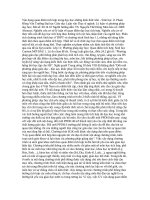x0041 lect8 pol morebook vn 0563
Bạn đang xem bản rút gọn của tài liệu. Xem và tải ngay bản đầy đủ của tài liệu tại đây (182.93 KB, 7 trang )
1
Advanced Programming
Lecture 7
Inheritance
Abstract Classes and Methods
• Abstract classes
– Cannot be instantiated
– Used as base classes
– Class definitions are not complete – derived classes must
define the missing pieces
– Can contain abstract methods and/or abstract properties
• Have no implementation
• Derived classes must override inherited abstract methods and
properties to enable instantiation
Abstract Classes and Methods
• Concrete classes use the keyword override to
provide implementations for all the abstract
methods and properties of the base-class
• Any class with an abstract method or property
must be declared abstract
• Even though abstract classes cannot be
instantiated, we can use abstract class references to
refer to instances of any concrete class derived
from the abstract class
Case Study: Inheriting Interface and
Implementation
• Abstract base class Shape
– Concrete virtual method Area (default return value is 0)
– Concrete virtual method Volume (default return value is 0)
– Abstract read-only property Name
• Class Point2 inherits from Shape
– Overrides property Name (required)
– Does NOT override methods Area and Volume
• Class Circle2 inherits from Point2
– Overrides property Name
– Overrides method Area, but not Volume
• Class Cylinder2 inherits from Circle2
– Overrides property Name
– Overrides methods Area and Volume
Case Study: Payroll System
• Base-class Employee
– abstract
– abstract method Earnings
• Classes that derive from Employee
–
–
–
–
Boss
CommissionWorker
PieceWorker
HourlyWorker
• All derived-classes implement method Earnings
• Driver program uses Employee references to refer to
instances of derived-classes
• Polymorphism calls the correct version of Earnings
54
1
// Fig. 10.23: Interfaces2Test.cs
2
// Demonstrating polymorphism with interfaces in
3
// Point-Circle-Cylinder hierarchy.
4
5
using System.Windows.Forms;
6
7
public class Interfaces2Test
8
{
9
public static void Main( string[] args )
10
{
11
// instantiate Point3, Circle3 and Cylinder3
objects
12
Point3 point = new Point3( 7, 11 );
13
Circle3 circle = new Circle3( 22, 8, 3.5 );
14
Cylinder3 cylinder = new Cylinder3( 10, 10,
3.3, 10 );
15
16
// create array of IShape references
17
IShape[] arrayOfShapes = new IShape[ 3 ];
18
19
// arrayOfShapes[ 0 ] references Point3
object
20
arrayOfShapes[ 0 ] = point;
21
55
32
foreach ( IShape shape in arrayOfShapes )
33
{
34
output += "\n\n" + shape.Name + ":\nArea
= " +
35
shape.Area() + "\nVolume = " +
shape.Volume();
36
}
37
38
MessageBox.Show( output, "Demonstrating
Polymorphism" );
39
}
40
}









